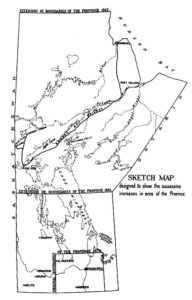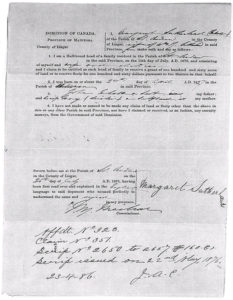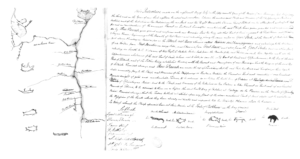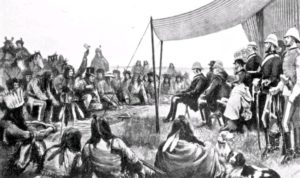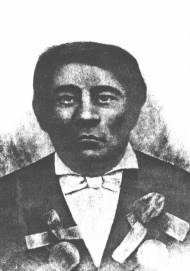The People of Red River Settlement before Confederation.
Red River Settlement was a colony built at the forks of the Red and Assiniboine rivers long before Confederation. It would become the city of Winnipeg.
It became an official colony in 1812 with the arrival of settlers from the Scottish Highlands, known today as Selkirk Settlers. They sailed from their homeland to York Factory on Hudson Bay and travelled the waterways to Red River.However, those settlers were not the first residents of Red River Settlement.
Most residents were of First Nations and/or Métis/half-breed heritage.
Thousands of First Nation’s people had lived in the region for generations.
French and English explorers and fur traders arrived in the late 1600s and early 1700s and mixed with the First Nations people. Others referred to their children as Half-breeds (Cree/Scots or English) and Métis (Saulteaux/Ojibway and French).
After the Scottish settlers arrived, others followed. In 1872, the population of Red River Settlement totaled about 15,000 people.1Most residents were of First Nations and/or Métis/half-breed heritage.
Other residents were of European heritage from the countries of Scotland, England, Ireland, Germany, eastern Canada, and the United States. As the population grew, so did the settlement, reaching over a large area of land.
It extended north to Netley Creek, east to St. Boniface and west to White Horse Plains (Headingly).
The areas we now call St. Clements, St. Andrews, Selkirk, and East Selkirk were the northern extensions of Red River Settlement.
Before the concept of Confederation emerged, there was no Canada. There was only open, unbound land, and lots of it. Red River Settlement was among the unbound land, in the center of the continent with key waterways that enabled travelers to reach it from all directions.
Arrival of Fur Trade
In 1670, the Hudson’s Bay Company and its English and Scottish fur traders arrived on the coast of James Bay in northern Ontario and Quebec, and later Hudson’s Bay in northern Manitoba. When King Charles II of England established the Hudson’s Bay Company, he claimed all lands that drained into Hudson and James Bay.
He called his new territory Rupert’s Land. The territory he claimed was huge, about forty percent of modern-day Canada from Alberta to Quebec and from Hudson Bay south to the northern United States. Red River Settlement was in the territory of Rupert’s Land.
Hudson’s Bay Company employees formed trade relationships with the local First Nations groups. They were primarily Cree peoples.European/First Nation Marriage
Many men formed marital unions with Cree women based on Cree marriage custom and ceremony. Both the Cree people and the European traders respected the custom and most unions were long lasting.
Many men formed marital unions with Cree women based on Cree marriage custom and ceremony. Both the Cree people and the European traders respected the custom and most unions were long lasting.
The ancestral Cree did not practice Christianity. They followed their own spiritual traditions, based on Earth-based spiritual teachings that said Nature was divine, and all things in Nature are connected.
The children born to Cree mothers and European fathers shared a rich ancestry of two different continents. However, others looked down on them calling them disrespectful names such as half-breed and mixed-blood.2 Today, most of their descendants call themselves Métis because they feel the old terms were racist and derogatory. However, the true Métis people hold a much different heritage than those of Cree/Scottish or English heritage. The Métis descend from Saulteaux (Ojibway) mothers and French fathers.
Over time, numerous fur traders and their Cree families moved south toward Red River Settlement where they met with other First Nation groups and European traders. Some of those traders were French from Quebec. They had travelled to the region of Red River in search of furs and riches too.
Along the way, they met a group of First Nations people near the Great Lakes. The French called them Saulteaux (pronounced Soto) meaning people who jump or shoot the rapids. They called them this because the people leaped and jumped across the rapids as they speared fish on the St. Mary’s River near modern day Sault Ste. Marie (Ontario).
Today, Saulteaux descendants call themselves Saulteaux, Ojibway, and/or Anishinaabee. Many French men formed marital unions with Saulteaux women based on Saulteaux marriage ceremony. Their children are the Métis. Most Métis people worked for The North West Company.
Those that moved to the region of Red River Settlement built a fort there called Fort Gibraltar. Several groups of Saulteaux people, including the legendary Chief Peguis, followed those traders. They established new camps on the banks of Netley Creek and places further inland near Lake Manitoba and Lake Winnipegosis.
On 1 July 1867, the British North American Act (BNA) passed, creating the Dominion of Canada. After the eastern colonies joined in Confederation, they wanted to link eastern Canada with the west coast of British Columbia and fill the land in-between with immigrant people. One way to do this was to build a transcontinental railway. The railway would cover 3,200 kilometres (2,000 miles) of swamps, bogs, rivers, prairies, and mountains from eastern Canada to British Columbia. The government named the new railway the Canadian Pacific Railway (CPR).
The railway would offer a faster, more direct route for long distant travel and an easier way to ship freight. It would also bring thousands of immigrant settlers into Rupert’s Land to build farms and settlements.
This region was home to thousands of First Nations and Métis people and so the government had to develop a plan to make room for the settlers and farmers among the first residents. They did this by issuing scrip to Métis/half-breed people and making Treaties and developing Reservations with First Nations people.
Most Métis people did not oppose either the new province or becoming Canadians. However, they did oppose the government’s secretive way of making the transfer, without the regional people’s consent or input in negotiations.
How Manitoba became a Province
Manitoba became a province and joined Confederation in 1870. However, in order to tell the story of how this came to be we need to go back a little further in history.
- In 1670, the Hudson’s Bay Company claimed ownership of Rupert’s Land and ruled over it for 200 hundreds.
- By the mid 1860s, Hudson’s Bay Company officials agreed to transfer the land to the newly formed country of Canada and negotiations began in the late 1860s to create the new province of Manitoba.
The government did not ask the majority of Métis peoples of Red River Settlement or the First Nations peoples of Rupert’s Land if they wanted to become part of the new province or country before negotiations began. Most Métis people did not oppose either the new province or becoming Canadians. However, they did oppose the government’s secretive way of making the transfer, without the regional people’s consent or input in negotiations.
Métis Concerns
The Métis peoples wanted their voices heard in the decision-making process that would surely affect their lives and the lives of generations to follow. They wanted to elect their own government, rather than have British-European politicians in Ottawa govern them.
They sought to preserve Métis rights and culture, and had concerns over the land of which they were born: would the waves of English-speaking settlers invade the lands of their birth and push them out. These were honest concerns as the government had already disregarded the Métis and First Nations people in the land transfer negotiations
In the fall of 1869, the government went ahead with their plan to complete the land transfer. They sent Governor William McDougall to Red River Settlement for negotiations. A patrol of armed Métis guards met him when he arrived and denied him access.
Louis Riel’s Government
![Louis Riel's Provisional Government 2nd row, 3rd from left, Louis Riel Back row, 3rd from left, Thomas Bunn [click to enlarge]](https://redrivernorthheritage.com/wp-content/uploads/2017/02/1870-Riel-Provincional-Govt-council-01-300x236.jpg)
Louis Riel’s Provisional Government
2nd row, 3rd from left, Louis Riel
Back row, 3rd from left, Thomas Bunn [click to enlarge]
The Canadian government did finally acknowledge Riel’s provincial government and negotiations between the two forms of government. Métis Leader, Louis Riel moved along.
The government ceded lands to the Métis people and the formation of the province became a reality. On 12 May 1870, the Manitoba Act received royal assent. It went into effect on 15 July 1870. Manitoba became Canada’s fifth province.
Initially the province was small, only about 13,000 square acres. It received the nickname Postage Stamp Province because it was so small. Its northern boundary stopped at modern day Winnipeg Beach. However, provincial boundaries extended in 1881 and again in 1912.
What does the name Manitoba mean?
No one knows with certainty who suggested the name, Manitoba, or the word’s true meaning. It is a First Nation’s word, but from which language it derives, we cannot say for sure.Steeped in ancient lore and legend, First Nations ancestors described the region of Manitoba as a place of Spirit, especially so in the narrows of Lake Manitoba northwest of the city of Winnipeg.
There, strong winds send waves crashing against the limestone shore rocks creating a rhythmic surge like the powerful, steady beat of a drum, which the ancestors believed was the heartbeat of the Great Spirit (Creator).
The Cree words Manitou (Great Spirit) and Wapow (Narrows), and the Ojibway word Manitou-aa-bau describe the narrows as a place where the Great Spirit is heard, or where the Great Spirit sits.
During negotiations with the Métis peoples over the transfer of land from the Hudson’s Bay Company to Canada, the Canadian government ceded 1.4 million acres to Métis/Half-breed families residing in the territory at the time of the land transfer. Termed then as the Northwest Half-breed Scrip, today it is Section 31 Manitoba Act Affidavits. Scrip is a term used to “describe a certificate, voucher, etc, establishing the bearer’s right to something.”3 In this case, the voucher was for land and/or money.
However, the process was fraught with error. First off, the government divided the 1.4 million acres based on an inaccurate census of the province in 1870, excluding several thousand people. As a result, many people did not receive their entitlement. Secondly, the government took over five years to distribute the land to the people. Consequently, hundreds of applicants did not receive their land or money due to death, relocation, or omission.4 The stigma of describing oneself as a half-breed brought disadvantage, shame and poverty for many and it extinguished any right to future First Nation entitlement.
Scrip policy did not protect Métis/half-breed lands nor did it secure political representation with the federal government. What it did do was help assimilate many Métis/half-breed people into European-Canadian culture that was fast approaching from eastern Canada.The Canadian Government told the Métis people that no prosecution would befall anyone who participated in the 1869 resistance. The government did not keep that Métis Half-breed scrip application promise.
In the summer of 1870, the government sent a military expedition to Red River to avenge Thomas Scott’s death. They killed one Métis leader of the resistance, and forced others, including Louis Riel, to flee the territory. The government delayed the transfer of land they had promised to the Métis/half-breed peoples. Many people left the region and moved west as the flow of immigrants from Ontario steadily arrived. A major transformation came to the Métis/half-breed people of Red River Settlement.
Peguis/St. Peter’s Band and Settlement
Prior to the region becoming the province of Manitoba, the land between east/west Selkirk and Lake Winnipeg was reservation land. It had belonged to the Peguis/St. Peter’s Band for over fifty years.
On July 18, 1817, Chief Peguis officially claimed it when he and four other indigenous leaders, Le Sonnant, Le Robe Noir, L’homme Noir, and Premier, signed the first treaty of the region along with Lord Selkirk (Thomas Douglas), the first European to officially claim land in the settlement. Known as the Selkirk Treaty, it affirmed land to each of the six signatories.5
Chief Peguis and Reverend William Cockran
Peguis was born in 1774 near Sault Ste. Marie (Ontario). He and his Band immigrated to the region of Red River Settlement in the late 1780s and settled on the banks of Netley Creek. Peguis befriended the Selkirk Settlers and early missionaries who arrived after him. He developed a special friendship with Rev. William Cockran. Together, they established the community of St. Peter’s in the early 1830s, although the community did not receive its name until 1852 when they built the stone church.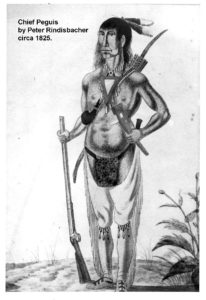
Saulteaux man, possibly Chief Peguis, Sketch by Peter Rindisbacher, Archives of Manitoba [click to enlarge]
Rev. Cockran did convert Peguis and many of his people to Christianity. They began to dress in European style clothing and lived in log houses similar to settler’s houses. The community prospered with the building of several homes, barns, outbuildings, a blacksmith shop, a church, and a school. The people cultivated several acres of land into wheat fields and potato crops and they raised cattle, sheep, and horses. The community extended along both sides of Red River.
Treaty One
After Manitoba became a province, the Canadian government began land negotiations with First Nations people in the region. Many First Nations peoples did not understand the concept of owning land or Confederation. Nor did they speak or write the English language. This put them at a great disadvantage in negotiations with the new Canadian Government.
However, the government moved along in its plan to make room for the railway, European-Canadian settlement and industry. With the First Nations people, the government created a Treaty – a formal and legal agreement with promises and commitments made between the government and the First Nations peoples of the region.
The Canadian government did not acknowledge the land agreement made between Chief Peguis and Lord Selkirk fifty-three years earlier. Instead, the government, on behalf of Her Majesty the Queen of England, began new negotiations and they re-surveyed the land.They established new boundaries to create the first post-Confederation treaty called, Treaty One. It stated the government would receive large tracts of land throughout the province of Manitoba. First Nations peoples received lands as well but much smaller tracts referred to as Reservations. This began the Reservation system in western Canada.
Chief Peguis had died by the time Treaty One came into effect. His son Mis-koo-kenew (Red Eagle) – (Christian name Henry Prince), represented the Peguis/St. Peter’s Band. He signed Treaty One on 3 August 1871 at Lower Fort Garry. Several other chiefs representing the Bands of Brokenhead, Long Plain, Roseau River, Sagkeeng, Swan Lake, and Sandy Bay also signed Treaty One.Treaty One stated that members of the Peguis/St. Peter’s Band were entitled to, “so much of land on both sides of the Red River, beginning at the south line of St. Peter’s Parish, as will furnish one hundred and sixty acres for each family of five.”6 The new southern boundary of Peguis/St. Peter’s Reserve began slightly south of Sugar Point, the thumb-like piece of land that sticks out into the river near modern-day Selkirk Golf Club.
Residents of East/West Selkirk
During the time of Confederation, residents of the east/west Selkirk region were a multi-cultural group of First Nations, Métis/half-breed peoples, and European immigrants.
Saulteaux/Ojibway People
- Immigrated from eastern Canada near Sault Ste. Marie (Ontario) in the late 18th century
- Settled at Netley Creek and then St. Peter’s Settlement
- Chief Peguis was the leader of the Band
- Belonged to Peguis/St. Peter’s Band
- Traded furs and goods with the North West Company and the Hudson’s Bay Company
- Some women formed marital unions with French fur traders. They are the ancestors of the Métis people
Cree Peoples
- Lived on the Plains, Forests, and Swampy regions
- Immigrated from the north, from places like Norway House, York Factory, and Churchill River
- Traded furs and goods with the Hudson’s Bay Company mostly
- Some women formed marital unions with Scottish and English fur traders. Others called their children Half-breeds and/or mixed-bloods
Métis/Half-breed
- A mix of First Nation and European ancestry
- Many Métis/half-breed people resided in the Selkirk area and north toward Lake Winnipeg
Non-indigenous peoples
- Scottish
- English
- French
- Irish
- German
- Immigrants from eastern Canada
Did You Know?
- Winnipeg was once called Red River Settlement.
- East and west Selkirk were the northern extension of Red River Settlement.
- Manitoba became a province on 12 May 1870.
- Louis Riel fought for the rights of the Métis people.
- Peguis was a Saulteaux chief, also called the Cut-Nose Chief, because he had part of his nose bitten off.
- The first post-Confederation Treaty, Treaty One, was signed on 3 August 1871 as Lower Fort Garry.
British North American Act (BNA): The BNA Act is the base document for the Canadian Constitution
CPR: Canadian Pacific Railway
Cree: A First Nations person
Confederation: a union of alliance of provinces or states
First Nations: people native or belonging naturally to a place
Fort Garry: A Hudson’s Bay Company fur trade post built at the forks of the Red and Assiniboine River in the early 1800s
Half-breed: People of First Nations and European heritage, primarily of English or Scottish fathers and Cree mothers
Hudson’s Bay Company: English based fur-trade company that built fur-trade posts on the coasts of James and Hudson Bay. Its early headquarters was at York Factory on Hudson Bay. It hired only men, primarily of Scottish and English heritage who married Cree woman from North America. It is the oldest commercial corporation in North America.
Immigrants: people who moved to a new country
King Charles: King of England (1630-1685) reigned over England, Scotland, and Ireland
Métis: People of First Nations and European heritage, primarily from French fathers and Saulteaux (Ojibway) mothers.
Queen Victoria: Queen of England (1819-1901) was the Queen of England and Ireland from 1837 until her death in 1901.
Red River Settlement: precursor of Winnipeg
Reservation: An area of land owned and managed by a community of First Nations peoples
Rupert’s Land : the name given to most of western Canada by King Charles II in 1670
Scrip: A term used to describe a certificate or voucher that shows the bearer’s right to something. For example land.
Treaty: A formal and legal agreement with promises and commitments made between two groups of peoples.
Publications
Grant, George M., Ocean to Ocean: Sandford Fleming’s Expedition Through Canada in 1872 (Toronto: Prospero Books, 2000)
Hallowell, Irving A., (edited with preface and foreword by Jennifer S. H. Brown), The Ojibwa of Berens River (Harcourt Brace College Publishers, 1992)
Mercredi Ovide & Turpel, Mary In the Rapids: Navigating the Future of First Nations (Toronto: Viking, 1993)
Peers, Laura The Ojibway of Western Canada 1780 to 1879 (Winnipeg: University of Manitoba Press, 1994)
Potyondi, Barry, Selkirk: The First Hundred Years 1882-1982 (1981)
Sealey, D. Bruce and Lussier, Antoine S., The Métis: Canada’s Forgotten People (Pemmican Publications: Winnipeg, 1975)
Sutherland, Donna G. Peguis: A Noble Friend (St. Andrews: Chief Peguis Heritage Park Inc, 2003)
Sutherland, Donna G. Nahoway: A Distant Voice (Petersfield: White Buffalo Books, 2008)
Websites
Birth of Manitoba, Life & Times at Manitobia at:
http://manitobia.ca/cocoon/launch/en/themes/bom
Confederation for Kids at Library and Archives Canada at:
http://www.collectionscanada.gc.ca/confederation/kids/index-e.html
Local and Provincial Items, Manitoban and Northwest Herald Newspaper, 3 August 1872, On-line at: www.Manitobica.ca
Manitoba Act at “Encyclopedia, The Encyclopedia of Music in Canada at:
http://www.thecanadianencyclopedia.com/index.cfm?PgNm=TCE&Params=A1ARTA0005070
Northwest Half-breed Script Métis National Council at:
http://tomcat.sunsite.ualberta.ca/MNC/scrip1.jsp
“People” Confederation for Kids at Library and Archives Canada On-line at:
http://www.collectionscanada.gc.ca/confederation/kids/023002-3000-e.html
Red RiverColony (Settlement) at Wikipedia at:
http://en.wikipedia.org/wiki/Red_River_Colony
Sault Ste. Marie, Ontarioon-line Wikipedia at:
http://en.wikipedia.org/wiki/Sault_Ste._Marie,_Ontario
Treaty Relations Commission of Manitoba on-line at:
http://www.trcm.ca/
By Donna Sutherland
- George M. Grant, Ocean to Ocean: Sandford Fleming’s Expedition Through Canada in 1872, p. 66
- Donna G. Sutherland, Nahoway: A Distant Voice, p 51-52
- Métis National Council at: http://tomcat.sunsite.ualberta.ca/MNC/scrip1.jsp
- Métis National Council at: http://tomcat.sunsite.ualberta.ca/MNC/scrip1.jsp also see: D. Bruce Sealey and Antoine S. Lussier, The Métis Canada’s Forgotten People
- Donna G. Sutherland Peguis: A Noble Friend, p. 64
- Treaty Relations Commission of Manitoba on-line at: http://www.trcm.ca/
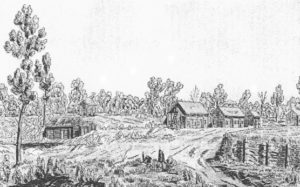
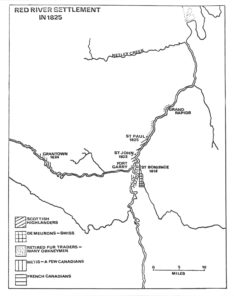
![Map of Hudson Bay by Tim Vasquez [click to enlarge]](https://redrivernorthheritage.com/wp-content/uploads/2012/01/3-300x247.jpg)
